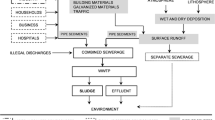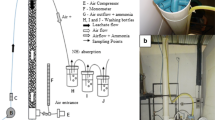Abstract
In this paper, emission and distribution behavior of six heavy metals (As, Cd, Cr, Ni, Pb, and Hg), particulate matter and mass distribution of mercury within the different streams of a fluidized bed sewage sludge incinerator are presented. At the inlet of air pollution control devices (APCDs); Cd, Cr, Ni and Pb were mainly enriched in coarse particles; comparatively As content was higher in fine particles (<PM2.5). The concentration of heavy metals in total particulate matter and PM2.5, at the inlet of APCDs, were in the order of Cr > Ni > Pb > As > Cd. Mercury was almost always distributed in flue gas. Metals, other than mercury, were efficiently removed in APCDs and their concentrations in bottom ash, with fly ash being higher, whereas for that in wastewater, then waste sand was lesser. Overall mercury removal efficiency of APCDs was 98.6 %. More than 83.3 % of mercury was speciated into oxidized form at the inlet of APCDs, attributed by higher chlorine content in sludge. Mercury was mainly distributed in wastewater (78.4 %), wastewater from a spray dry reactor (16.8 %), fly ash in a hopper (3.4 %) and flue gas (1.4 %). This result is one of the first for data to be obtained; more experiments are required to control emission from such sources.




Similar content being viewed by others
References
Zabaniotou A, Theofilou C (2008) Green energy at cement kiln in Cyprus—use of sewage sludge as a conventional fuel substitute. Renew Sustain Energy Rev 12:531–554
Werther J, Ogada T (1999) Sewage sludge combustion. Prog Energy Combust Sci 25:55–116
Stasta P, Boran J, Bebar L, Stehlik P, Oral J (2006) Thermal processing of sewage sludge. Appl Therm Eng 26:1420–1426
Dogru M, Midilli A, Howarth (2002) Gasification of sewage sludge using a throated downdraft gasifier and uncertainty analysis. Fuel Process Technol 75:55–82
GroßB, Eder C, Grziwa P, Horst J, Kimmerle K (2008) Energy recovery from sewage sludge by means of fluidized bed gasification. Waste Manage 28:1819–1826
Werle S, Wilk RK (2010) A review of methods for the thermal utilization of sewage sludge: The Polish perspective. Renew Energ 35:1914–1919
Mullen J (1992) Consider fluid-bed incineration for hazardous waste destruction. Chem Eng Prog 50:50–58
Mininni G, Sbrilli A, Guerriero E, Rotatori M (2004) Dioxins and furans formation in pilot incineration tests of sewage sludge spiked with organic chlorine. Chemosphere 54:1337–1350
Balogh SJ, Nollet YH (2008) Mercury mass balance at a wastewater treatment plant employing sludge incineration with off gas mercury control. Sci Tot Environ 389:125–131
Kim JH, Park JM, Lee SB, Pudasainee D, Seo YC (2010) Anthropogenic mercury emission inventory with emission factors and total emission in Korea. Atmos Environ 44(23):2714–2721
Sorme L, Lagerkvist R (2002) Sources of heavy metals in urban wastewater in Stockholm. Sci Tot Environ 298:131–145
Velden MV, Dewil R, Baeyens J, Josson L, Lanssens P (2008) The distribution of heavy metals during fluidized bed combustion of sludge (FBSC). J Hazard Mater 51:96–102
Aonghusa CN, Gray NF (2002) Laundry detergents as a source of heavy metals in Irish domestic wastewater. J Environ Sci Heal A37:1–6
US EPA, Method EMTIC TM-5 (2000) Determination of particulate matter emissions from stationary sources
US EPA Method (1986) Test method for evaluating solid waste, SW-846-3050B, Acid digestion of sediments, sludges, and soils, 3rd edn. US EPA, Office of Solid Waste and Emergency Response, US Government Printing Office, Washington DC
Yoon YS, Kim JH, Pudasainee D, Son SU, Park GK, Park KII, Seo YC (2010) Emission characteristics of PM and PM2.5 from bituminous coal-fired power plants (in Korean). J Korea Soc Atmos Environ 26(2):151–160
Meij R (1989) Tracking trace elements at a coal fired plant equipped with a wet flue gas desulphurization facility. Kema Sci Technol Rep 7(5):269–355
Goodarzi F, Huggins FE, Sanei H (2008) Assessment of elements, speciation of As, Cr, Ni and emitted Hg for a Canadian power plant burning bituminous coal. Int J Coal Geol 74(1):1–12
Helble JJ (1994) Trace element behavior during coal combustion: results of a laboratory study. Fuel Process Technol 39:159–172
Germani MS, Zoller WH (1988) Vapor phase concentrations of arsenic, selenium, bromine, iodine and mercury in the stack of a coal-fired power plant. Environ Sci Technol 24:1079–1085
Kozinki J, Rink K (1995) Combustion of sludge waste in FBC. Distribution of metals and particle sizes. In: Proceedings 13th international conference on fluidized bed combustion, Orlando, FL, pp 305–315
Yan R, Gauthier D, Flamant G (2001) Partitioning of trace elements in the flue gas from coal combustion. Combust Flame 125(1–2):942–954
Sanger M, Werther J, Hanssen H (1999) Concentrations and mass balance of mercury in a fluidized bed sewage sludge incineration plant. In: Proceeding of the 15th international conference on FBC, ASME
Pudasainee D, Kim JH, Seo YC (2009) Mercury emission trend influenced by stringent air pollutants regulation for coal-fired power plants in Korea. Atmos Environ 43:6254–6259
Kim JH, Seo YC, Pudasainee D, Lee SH, Cho SJ, Jang HN, Park JM, Song GJ, Park KS (2009) Efforts to develop regulations in Korea similar to the US Maximum Achievable Control Technology (MACT) regulations for hazardous waste incinerators. J Mater Cycles Waste Manag 11:183–190
Pudasainee D, Lee SJ, Lee SH, Kim JH, Jang HN, Cho SJ, Seo YC (2010) Effect of selective catalytic reactor on oxidation and enhanced removal of mercury in coal-fired power plants. Fuel 89:804–809
Pudasainee D, Kim JH, Lee SH, Park JM, Jang HN, Song GJ, Seo YC (2010) Hazardous air pollutants emission from coal and oil-fired power plants. Asia-Pac J Chem Eng 5(2):299–303
Shaub W (1993) Mercury emissions from MSW incinerators, an assessment of the current situation in the United States and forecast of future emissions. Resour Conserv Recy 9:31–39
Galbreath K, Zygarlicke CJ (1996) Mercury speciation in coal combustion and gasification flue gases. Environ Sci Technol 30:2421–2426
Laudal D, Brown T, Nott B (2000) Effects of flue gas constituents on mercury speciation. Fuel Process Technol 65–66:157–165
Meij R, Vredendregt L, Winkel H (2002) The fate and behavior of mercury in coal-fired power plants. J Air Waste Manage Assoc 52:912–917
Pudasainee D, Kim JH, Yoon YS, Seo YC (2012) Oxidation, reemission and mass distribution of mercury in bituminous coal-fired power plants with SCR, CS-ESP and Wet FGD. Fuel 93:312–318
Kim JH, Pudasainee D, Yoon YS, Son SU, Seo YC (2010) Studies on speciation changes and mass distribution of mercury in a bituminous coal-fired power plant by combining field data and chemical equilibrium calculation. Ind Eng Chem Res 49:5197–5203
Acknowledgments
This study was supported by the Korea Ministry of Environment under the human resource development project for energy from waste and recycling. This research has also been financially supported by the R&D project of New & Renewable Energy, “Fluidization Combustion Technology of Sludge and RDF using Mixture of Recirculating Flue-gas and Oxygen,” funded by the Korea Institute of Energy Technology Evaluation and Planning (KETEP).
Author information
Authors and Affiliations
Corresponding author
Rights and permissions
About this article
Cite this article
Pudasainee, D., Seo, YC., Kim, JH. et al. Fate and behavior of selected heavy metals with mercury mass distribution in a fluidized bed sewage sludge incinerator. J Mater Cycles Waste Manag 15, 202–209 (2013). https://doi.org/10.1007/s10163-013-0115-z
Received:
Accepted:
Published:
Issue Date:
DOI: https://doi.org/10.1007/s10163-013-0115-z




